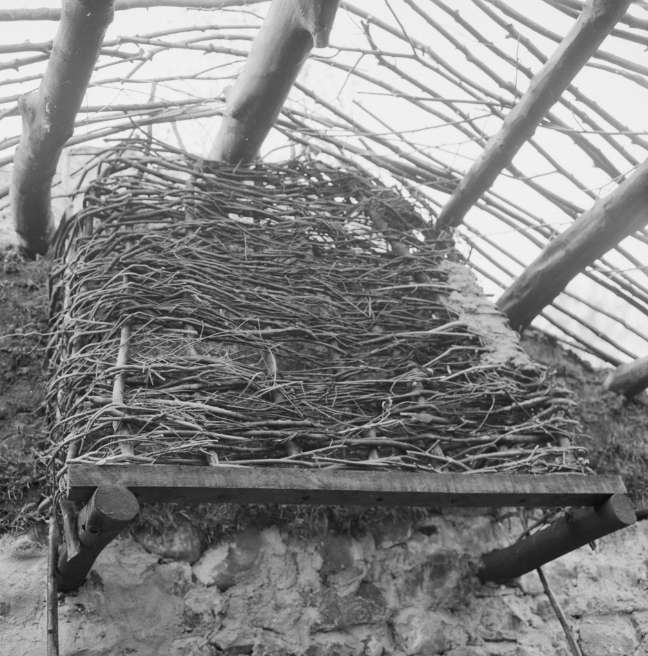
Where is it from?
Duncrun Cottier’s House came to the Ulster Folk Museum in 1961 from the district of Magilligan, northwest County Londonderry.
It was nestled beneath Binevenagh Mountain. It was a small house, with only a tiny piece of land at the back that housed a small garden. It sat on the boundary between two farms.
Why is it special?
Duncrun Cottier’s House was the first vernacular building to be moved and rebuilt at the Ulster Folk Museum. It is thought to have been built in the mid-late 1700s, and reputed to be the oldest surviving vernacular house from the area. By 1940, it had started to attract visitors who were keen to see one of the few remaining thatched houses in the northwest.
The house has a number of interesting structural features, including: a roped down and pegged thatched roof; a roof that is supported not by its walls but by bog oak cruck trusses or beams; sods of turf used in the construction process (within walls and at the base of chimney); and a wattled clay-covered chimney hood.
What is it like inside?
The house has only two rooms: a kitchen with a bed outshot and a separate bedroom. A third room was added at some point in the life of the house, but this was not recreated at the museum.
The house consists of a kitchen and a single bedroom. An infill of sod was used along the upper part of the hearth gable and on the top of the back wall of the bedroom.
The hearth fire has its original wooden framed, clay plastered chimney canopy. In the far kitchen corner beside the hearth there is the bed outshot. This built-in arrangement for a bed helped to save space within the kitchen. The bed outshot was typical of traditional Irish rural housing in the north and west of Ulster.

Who lived there?
Duncrun Cottier’s House was built for a rural labourer and his family. The word cottier refers to a labourer who rents a small parcel of land.
Several generations of two local Magilligan families lived in the house – the Doherty family, followed by the Clyde family. Both families were interrelated by marriage. Neither family was wealthy; they were landless cottiers who rented their home from a local farmer. The men tended to work as agricultural or railway labourers, while the women worked as seamstresses or domestic servants.
The last person to live in the house was Margaret Clyde. Margaret Clyde was born in Duncrun and she lived in her family home for nearly ninety years. In the 1901 census, Margaret’s occupation was given as a dressmaker. She was 30 years old. Also living in the house were her parents; Patrick (an agricultural labourer) and Catherine, her brother William, aged 23 (also a labourer) and young nephew, Robert Butcher aged 10 years.
Eddie Butcher, the well-known traditional singer from Magilligan, was the nephew of Margaret Clyde. He used to thatch the house for her.
The museum’s sound archive contains many field recordings of Eddie, many taken by Hugh Shields. In 1969 the Ulster Folk Museum released the EP “Adam in Paradise” featuring his singing.
Life at Duncrun
No electricity was installed in the house, and there was no running water. The hearth fire, candles, and paraffin lamps provided light and heat, while water was brought from a roadside pump.
Cottiers were attracted to Duncrun because its surrounding environment was abundant in materials. Turf was readily available on the mountainside and could be cut for free. Bog supplied bog wood. Many cottiers kept a horse which could be rented out to farmers; some poultry could be kept, and if fortunate, a single cow. Pigs were also kept to pay the rent. Fishing was popular, as was illicit whiskey distilling.
At the time of 1901, very few people spoke Irish in the region. Common occupations included farmer, agricultural labourer, railway labourer, seamstress, and housekeeper.
Reflecting on his relationship with his Aunt Margaret and Duncrun Cottier’s House, Eddie Butcher said:
‘I done repairs to it, and went and pulled the thatch for it in the back strand hills there – the bent – and took it up and put it on and roped it down. I maybe done it, oh, maybe ten or twelve times for her while she had it. It had to be done very two or three years, you see. She always liked to keep it dry.’







